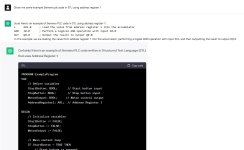AI allows people to make thousands of bad assumptions per second.
That is one of the best descriptions of AI I've ever heard. I'm filing that one away for the next time a customer asks me if I can deliver a 12 month project in 3 months using AI

I've had mixed results with AI.
I was looking at a very specific problem relating to Logix Motion PLC's a few months ago, and put in a call to Tech Support. I spoke to a rep I'm familiar with, that I'm confident knows his stuff. He said he wasn't sure off the top of his head and was working from home that day, but would set up a test rig in the office tomorrow and test it and call me back with the results.
In the meantime, my boss suggested I ask ChatGPT. I was skeptical, but asked it the question just to see what it would say. It gave me quite a detailed answer, which I would summarise as "not a
great solution, but a passable workaround if no other option exists".
The next day, Tech Support called me back, confirmed my suspicions of the limitation, and offered the exact same workaround that ChatGPT had provided.
I've had good results in two other instances - I have an absurdly over-engineered system keeping the plants on my balcony watered that gathers data from the local weather bureau, and emails me when something needs my attention. At some point the weather bureau changed how they made their data available, and Google turned off a security setting that my code relied on to send the emails. ChatGPT took my old code and updated it to work with the new restrictions in both cases, in only minutes instead of the days it took me to work it out on my own, several years back before ChatGPT existed.
Other times it's been...less than helpful. I've asked it to review some documentation for spelling errors or references to an irrelevant system that I copy/pasted the initial document as a basis for. It missed several. I've also tried to use it to help me find where to look for certain settings or functions as I learn a new SCADA platform (Wonderware) and it's been only slightly better than useless. It can't write ladder logic to save it's life, and some of the information it gives me sounds good but is flat out wrong.
For me, if it's helping me to do something that I already know how to do/would be able to work out given time and patience, it's a useful tool to help me along and automate some of the tedious grunt work. But if you're trying to use it to do something you don't know how to do yourself, you're not gonna have a good time.









